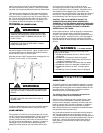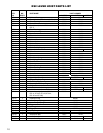
screw. If screw has been removed and replaced, always
use new spots for locking.
On the 3 ton unit, hang it in the vertical position. Making
sure there are no twists in the chain, feed the end of
chain thru the hook block (673-71) and around lower
sheave (637-70). Secure end of chain to hoist hanger
using the dead end pin (673-76).
G. Assemble the end ring (673-53) to the free (loose) end of
chain by rotating the last link 1/4 turn and passing the
ends of the ring thru the link as shown below. Hammer
or squeeze the ends of the ring together to secure it to
the chain.
CUTTING CHAINS
Hoistaloy
®
load chain is hardened for wear resistance and is
difficult to cut. However, the following methods are
recommended when cutting a length of new chain from
stock or cutting off a length of worn chain.
(1) Use a grinder and nick the link on both sides, then
secure the link in a vise and break off with a hammer.
(2) Use a 7 inch(177.8mm) minimum diameter by 1/8 inch
(3.175mm) thick abrasive wheel (of type recommended
by wheel supplier) that will clear adjacent links.
(3) Chain may also be cut using a bolt cutter with special
jaws for cutting hardened chain (1 inch (25.4mm) long
cutting edge).
TESTING
Prior to initial use, all altered or repaired hoists or hoists that
have not been operated for the previous 12 months must be
tested by the user for proper operation.
Test the unit first in the unloaded state and then with a light
load of 50 pounds (23kg.) times the number of load
supporting strands of load chain to be sure it operates
properly and the brake holds the load when the lever is
released; then test with a load of *125% of rated capacity.
In addition, hoists in which load sustaining parts have been
replaced shall be tested with *125% of rated capacity by or
under the direction of an appointed person and a written
report prepared for record purposes.
*If unit is equipped with a Load Limiter, it may refuse to lift
the 125% overload. Should this occur, reduce the test load
to rated capacity. Also, on such units, the function of the
Load Limiter should be checked. To do this attach the lower
hook to a load of 180% of rated capacity and operate the
unit in the “up” direction. When attempting to lift this load,
the lever should slip. If it does not, the Load Limiter must be
replaced. After this test, operate the unit in the “down”
direction to remove tension in the chain.
NOTE: For additional information on inspection and
testing, refer to the current issue of ASME B30.21
“Manually Lever Operated Hoists” obtainable from
ASME Order Department, 22 Law Drive, Box 2300,
Fairfield, NJ 07007-2300, U.S.A.
9
WARNING
CUTTING CHAIN CAN PRODUCE FLYING
PARTICLES.
TO AVOID INJURY:
• WEAR EYE PROTECTION.
• PROVIDE A SHIELD, SUCH AS A HEAVY RAG,
OVER THE CHAIN TO PREVENT FLYING PARTI-
CLES.
Cutting Chain with a Bolt Cutter
Cutting Chain by Nicking
Rotate Last
Link Of
Chain 90°
As Shown.
End Ring
673-53
Load
Chain
673-52
Bend
Ends To
Secure To
Chain


















